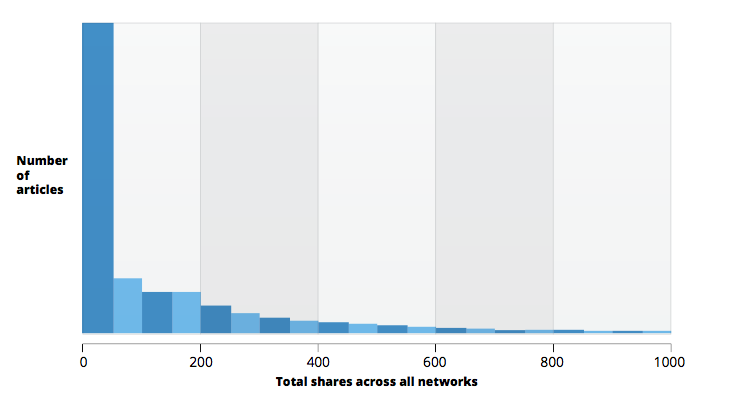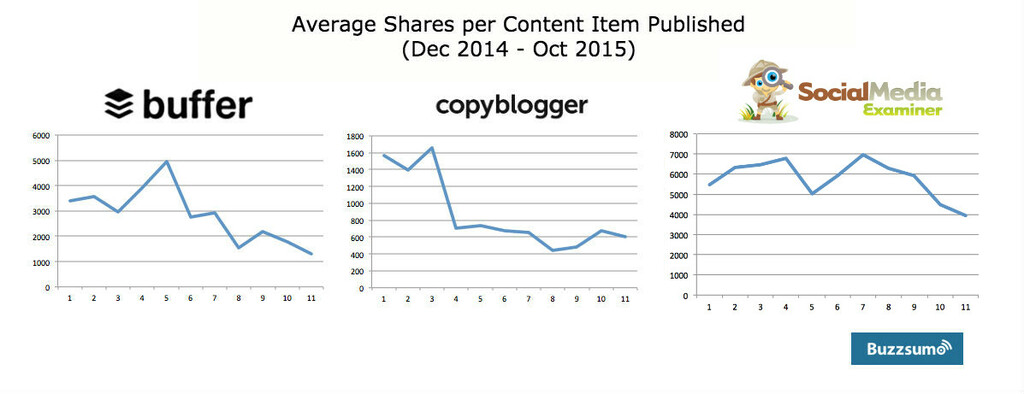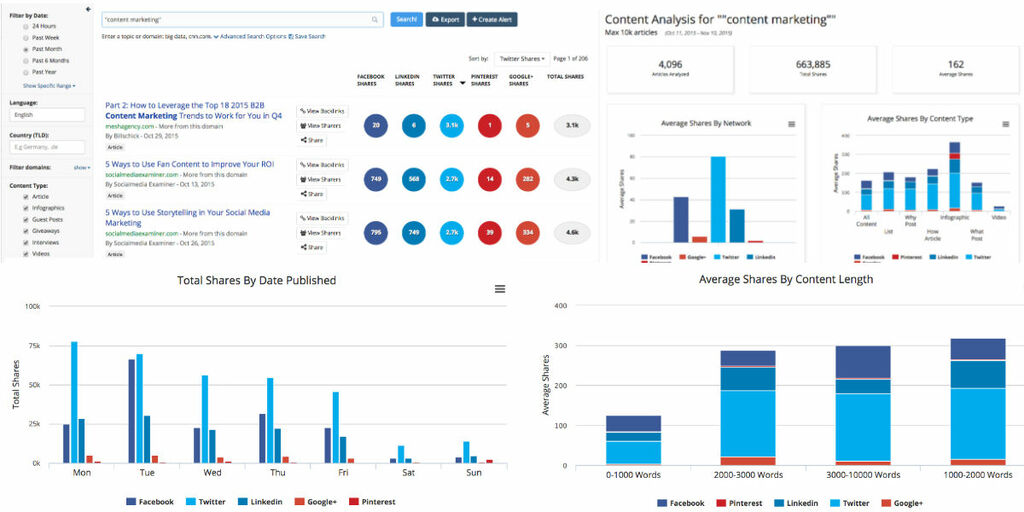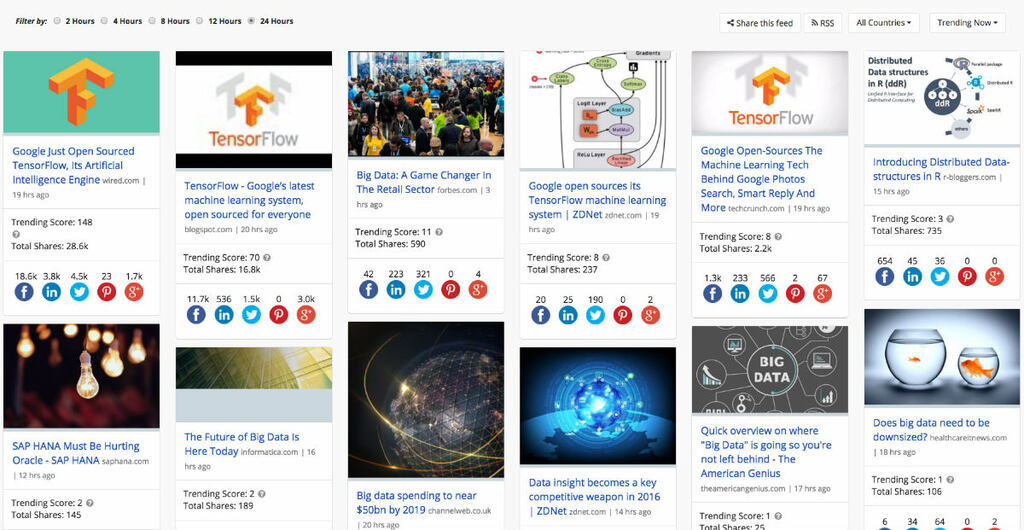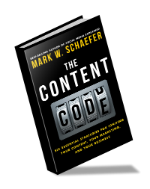What’s content shock? It’s a term coined by Mark Schaefer two years ago, when he observed that “content supply is exponentially exploding while content demand is flat.” The logical consequence of supply continually outstripping demand is that on average content articles will get less engagement. This harsh reality is confirmed by our analysis of 1m articles in a research project with Moz. When we say less engagement, we really mean it. We found that 50% of articles get 8 shares or less and even fewer links. No two ways about it, that’s tough. We take a detailed look at the issue of content shock, why content fails and what you can do to improve your odds.
Analysis of 1m Posts
Earlier this year we analyzed the shares and links of 1 million posts. The low level of content engagement we found was striking:
- 50% of randomly selected posts received 8 shares or less
- 75% of these posts received 39 shares or less
- 75% of these posts achieved zero referring domain links
That last stat again: 3 in 4 posts got zero referring domain links. Shares are easier to achieve but even so, most content gets very few shares, as can be seen from the chart below. The chart is cut off on the right at 1,000 shares, in reality it stretched out to over 100,000 shares for some articles.
Our research explored the shares and links by network and by content formats. We also looked at the correlation of shares and links, and at the content that achieved both high numbers of shares and links.
Download the 30 page Research Report
Our research findings are consistent with recent research by Trackmaven that found 42% of professionally marketed blog posts receive less than 10 interactions.
Why is Content Failing?
The findings could simply mean that people are producing poor content which is not worthy of sharing. Are we all really that bad? However, I suspect this is not the case. Whilst in earlier years it was possible that if you produced good content it would get found and shared, almost by virtue of its quality, this is no longer the case. There is now so much content that even producing great content is not enough. The bar is way higher.
Popular sites with great content are also being affected by content shock. Buffer recently published a very open and honest post, with all their normal transparency, that highlighted they had lost 50% of their social traffic. And it’s not because Buffer decided to start writing poor content. It’s the ‘content crush’ as they call it. There may be more similar content but fundamentally there is just too much other stuff out there. Also what worked last year may no longer work this year, we all have to keep testing new content and adapting.
And it’s not just Buffer. We analyzed the average shares per content item published on Buffer, Socal Media Examiner, Moz and Copyblogger. The results surprised us. All the sites have seen a decline in the average shares they achieve as we can see below.
We saw a similar decline on average for all content published on Moz but the shares just for their own Moz blog have remained constant, they have multiple blogs and content.
No one would argue these are not great sites, arguably they are actually exemplar sites when it comes to content. However, they are not immune from content shock. In our analysis sites have increased their content output and in the case of CopyBlogger this has resulted in more total shares than last December but significantly less per post. This is consistent with Trackmaven’s recent analysis of content from 8,800 brands over the last 24 months which found the output of content per brand increased by 78% but average content engagement decreased by 60%. Thus the cost-effectiveness of content marketing appears to be declining.
What is clear is that producing great content is not enough on its own to drive views and engagement.
“The idea that ‘great content rises to the top’ is over.” Mark Schaefer
Content shock clearly affects everyone but unfortunately we are seeing common mistakes made by content producers that compound the problem.
Compounding The Content Shock Problem
From our analysis there are three mistakes people make which compounds the content shock problem and results in very low engagement. These three mistakes are:
- Lack of research, not understanding the content that resonates
- Lack of amplification, linked to what Mark Schaefer calls ignition
- Lack of monitoring, not tracking trends
Research
One of the common mistakes we see is rushing into content production without enough research. There is a lot of pressure on content teams to produce content consistently, so we understand why this happens. However, the battle for content engagement can be won or lost at the research stage, before any content is even written.
There is no magic wand but if you understand the content that resonates with your audience you have a better chance of increasing engagement. If you know the content your audience likes, shares and engages with, you can develop content that your audience will engage with and share. You can produce the best post in the world how to market to organic crop farmers in Somalia but if your audience is not interested in that topic you are wasting your time.
Your odds are greatly improved if your content answers the questions your audience is asking. Your support teams and sales teams will have good understanding of questions your customers and potential customers are asking. Identify these questions and as Lee Odden says “be the best answer”.
Research also includes understanding what competitors are doing and the content that is working for them.
You can start your research with a search for the most shared content on your topic using BuzzSumo. Most people look at the top content for the last year but it is useful to undertake analysis for the last month. For example, is the nature of content changing, what formats are working or not working, are certain networks becoming more important, etc? Is last month just a one-off or are you seeing new trends? Below is a quick analysis for “content marketing” articles and sharing over the last month.
Feed your research into your content plan when assessing content opportunities.
Amplification
One of the most disappointing things we see again and again is good content that was produced with no amplification strategy. You’re doubling down on your time-wasting.
You cannot assume that people will find your content or that people will share it. It’s hard enough for people to keep up with the content they desperately want to see, never mind your stuff. Before you create your content you need to understand how it will be amplified. Who will share it or link to it and why? The reality is that you need an outreach strategy which is hard work and takes time.
Mark Schaefer has highlighted the importance of what he calls content ignition and Eric Enge has emphasised the importance of content promotion. It doesn’t matter what you call it but you need to be clear how your content will get in front of people for them to engage with it. Social networks are increasingly important in content discovery. According to Shareaholic social networks are now the biggest drivers of discovery and traffic, more than search. Of these networks the most important is Facebook which alone drives over 25% of web traffic according to Pars.ly and Shareaholic.
As a minimum you need to understand how successful content gets amplified. Who shares it and links to it? How can you get them to do that for you? Also how important is paid distribution. Organic reach has fallen so low on some of the social networks that you will need to pay to get content amplified. Buffer has publicly said they’ll be trying more of this.
You need to be spending at least as much time on amplification as on content creation because we are sadly moving to a situation where amplification arguably matters more than the quality of content. Thus those with the best amplification strategies or the deepest advertising pockets may win out over quality content.
“We are in an era where advertising, promotion, and distribution strategies may eclipse the importance of the content itself.”
Mark Schaefer
Also do not believe that gaining lots of content shares will lead to links. Our research proved this to be a false assumption. People share and link for different reasons. Whilst there are areas of crossover to gain links requires content that has inherent value, is often long form, comprehensive, authoritative and evergreen. To gain links takes time and a determined link building strategy. It’s not a byproduct of social sharing.
Monitoring
Another mistake we see is a lack of monitoring and simply not tracking trends. From our analysis we can see that social sharing typically takes place very quickly, an article can explode in terms of social sharing but then die after a limited period of time. New industry announcements, reports and articles can all create short term peaks of interest. If you act quickly the trend is your friend. However, if you join the party at the end of things then you may find yourself all alone without a dance partner.
You can see this problem in microcosm in the people who schedule social media posts for later in the week about today’s hot topic, not realising that by the time their post is shared people will have moved on or even be bored by the articles that are engaging them today. Below are the articles trending on Big Data as I write this post. Google’s open source release of its Artificial Intelligence engine is the trending topic. Maybe there is an opportunity for me to get involved by sharing relevant content, asking my audience questions, interviewing experts for their views or being one of the first people to use the tool and creating a case study.
Shares happen much faster than links and it is essential that you keep on top of the trends and issues engaging your audience. Eric Enge highlights the importance of early mover advantage in his thoughtful post on surviving content shock.
Summary
So if 50% of content gets 8 or less shares and 75% gets zero links, what should you do? There is no easy answer to the issue of content shock and the challenges are almost bound to increase. However, you can do a lot to improve your odds through research, amplification and monitoring. Quality is still vitally important. But you have to give your quality content every chance of succeeding.
Categories
Content MarketingCategories
Content MarketingThe Monthly Buzz⚡
Subscribe to BuzzSumo's monthly newsletter to:
Stay up-to-date with the best of the best in content marketing 📝
Get data-informed content, tips and tidbits insights first 👩🏻💻
Read top shared content by top marketing geeks 🤓
Try
Enter any topic, term or url to search to see BuzzSumo in action. It’s free!
100% free. No credit card required.
